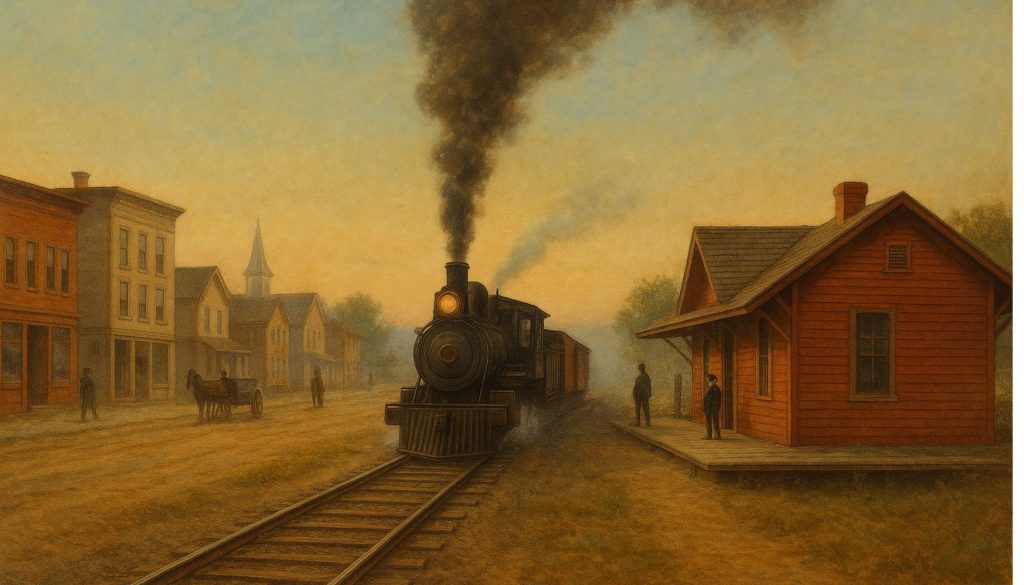A branch line in the context of railroading refers to a secondary railway line that diverges from a main line, primarily serving smaller communities, industrial areas, or regions with lower population density. Unlike their main line counterparts, which are engineered for substantial traffic volumes and typically link major urban centers or transportation hubs, branch lines are designed to accommodate lighter traffic and cover shorter distances. This distinction highlights their crucial role in providing more localized and specialized transportation services.
An Expanding Network
Let’s embark on a journey along one of these vital branch lines, exploring how railroads extended their reach into smaller communities and, in doing so, fundamentally transformed the populations they served. The advent and subsequent expansion of railroads exerted a profound influence on the fabric of small towns across the United States. By dramatically reducing both the cost and the time associated with transportation, railroads effectively unlocked new markets for local businesses, fostered the emergence of novel industries, and significantly streamlined the movement of both people and goods. This transformative impact laid the groundwork for significant economic and social shifts in previously isolated areas.
Our exploration begins with a detailed examination of the key economic impacts generated by the railroad system. Prior to the widespread adoption of rail, many small towns existed in a state of relative isolation, disconnected from broader economic networks. The arrival of railroads shattered this isolation, forging critical links between these towns and larger regional and national markets. This newfound connectivity provided local businesses with an unprecedented opportunity to ship their products to a far wider customer base, leading directly to increased sales and enhanced profits. Consider, for instance, the plight of farmers before the railroad: their markets were typically confined to the immediate vicinity, limited by the range of horse-drawn carts. With the railroad, they could now effortlessly transport their crops to distant cities, accessing a much larger and more lucrative market. Similarly, manufacturers gained the ability to ship their finished goods to retailers across the country, expanding their reach exponentially. This expansion of market access was a cornerstone of the economic revitalization experienced by many small towns.
Bringing Economic Growth
Beyond merely facilitating trade, the railroad industry itself acted as a powerful catalyst for industrial growth. The sheer scale of railroad construction and operation generated an enormous demand for a wide array of raw materials and manufactured goods, including lumber for ties and structures, iron and steel for rails and rolling stock, and coal to fuel the locomotives. This intrinsic demand spurred the growth of related industries in small towns strategically located along the developing railroad routes. Furthermore, the very presence of cheap and reliable transportation acted as a magnet for new factories and manufacturing plants. Businesses, recognizing the economic advantages of efficient raw material delivery and product distribution, were incentivized to establish operations in areas served by rail, thereby further invigorating local economies and creating new employment opportunities.
Changing Demographics
The impact of railroads extended beyond purely economic spheres, significantly influencing demographic patterns. Train service dramatically simplified the process of relocation, making it easier and more appealing for people to move to new areas. This ease of movement contributed directly to population growth in many small towns situated along rail lines. An expanding population, in turn, fueled increased demand for housing, a wider variety of goods, and essential services, thereby creating a fresh wave of economic opportunities for local businesses. This symbiotic relationship between rail infrastructure, population influx, and economic dynamism became a defining characteristic of 19th-century American development.
Later in the 19th century, as the burgeoning middle class experienced a rise in disposable income and leisure time, railroads embraced a new role in promoting tourism. The development of scenic routes and the accessibility of previously remote resort towns transformed these locations into popular destinations for travelers seeking relaxation and recreation. This nascent tourism industry brought substantial economic benefits to the local communities, stimulating the growth of hotels, restaurants, shops, and other service-oriented businesses. The ability to easily transport tourists to picturesque locales further diversified the economic base of many towns and contributed to their overall prosperity.
One Example: Lowell, Massachusetts
A quintessential illustration of the transformative power of railroads on small towns is the Boston and Lowell Railroad. Commencing operations in 1835, this pioneering railway forged a vital connection between the bustling city of Boston and the burgeoning textile mills of Lowell, Massachusetts. Its establishment marked a revolutionary turning point for the textile industry. The provision of cheap and efficient transportation allowed Lowell to readily import raw materials, particularly cotton, from around the world. Simultaneously, it enabled the swift and cost-effective shipment of its finished textile products to markets throughout the United States. This logistical advantage directly fueled the rapid growth of Lowell and its surrounding towns, creating an abundance of jobs and fostering widespread prosperity across the region.
The developments witnessed in Lowell, replicated in numerous other small towns across the nation, catalyzed a profound economic metamorphosis. The traditional agricultural-based economy, which had long been the bedrock of these communities, began to shift decisively towards one dominated by manufacturing and industry. This paradigm shift frequently resulted in substantial economic growth and unprecedented prosperity. Towns strategically situated along major railroad lines often evolved into significant commercial centers, effectively serving as crucial hubs for trade and transportation. This centrality, in turn, spurred the development of a diverse array of new businesses, including warehouses for storing goods, various retail shops to cater to the growing population, and hotels to accommodate travelers and merchants. The ripple effect of railroad connectivity extended deep into the fabric of these communities, reshaping their economic identity.
By the 1850s, Lowell had ascended to become the largest industrial complex in the United States. Its textile industry, a powerhouse of American manufacturing, relied heavily on cotton produced in the Southern United States. A striking statistic from 1860 underscores the scale of Lowell’s industrial might: the city boasted more cotton spindles than all eleven states that would subsequently form the Confederate States of America combined. This remarkable concentration of industrial capacity was a direct testament to the foundational role played by the Boston and Lowell Railroad. Following the conclusion of the Civil War, Lowell continued its trajectory of growth and prosperity as a major industrial center, attracting an ever-increasing influx of migrant workers and immigrants to staff its mills. The city reached its economic zenith by the outbreak of World War I in Europe. All of this remarkable industrial expansion and demographic shift can be traced back to the pivotal year of 1835, when the Boston and Lowell Railroad first connected the rapidly industrializing city of Lowell with the established commercial hub of Boston. As we have seen, this particular branch line played an absolutely crucial role in the explosive growth of Lowell’s textile industry and, in doing so, firmly established railroads as a vital and indispensable infrastructure for industrial growth throughout New England and beyond.
Not Without Challenges
However, the narrative of railroad expansion was not universally one of unmitigated success and prosperity. While railroads undeniably brought significant economic benefits to many communities, they also introduced a heightened level of competition among small towns. Communities that, for various reasons, were not fortunate enough to be located on major railroad lines often found themselves struggling to compete economically with those that were. This disparity in access to efficient transportation frequently led to economic stagnation or even outright decline in some cases. The “haves” and “have-nots” of the railroad era emerged, creating an uneven landscape of development where proximity to the rail network became a critical determinant of a town’s future. The initial promise of widespread prosperity sometimes gave way to a more nuanced reality of localized booms and busts, highlighting the complex and sometimes contradictory impacts of this transformative technology.
The profound influence of railroads extended beyond merely economic factors, permeating the social and cultural fabric of small towns. The increased accessibility brought by the rail network facilitated greater social interaction and cultural exchange. Previously isolated communities, once largely self-contained, were now more easily able to connect with people and ideas from other regions. This led to a diversification of social life, the introduction of new customs and trends, and a broadening of perspectives. Newspapers and mail services became more efficient, allowing for the faster dissemination of information and news, connecting small towns to national events and intellectual currents. This newfound connectivity gradually eroded the provincialism that often characterized isolated communities, fostering a more interconnected and informed citizenry.
Furthermore, the railroad’s presence often spurred the development of new public amenities and services. With a growing population and increased economic activity, towns often invested in better schools, libraries, and healthcare facilities. The availability of rail transportation also made it easier to procure construction materials and bring in skilled labor, further facilitating this infrastructural development. The railways themselves often employed a significant number of local residents, contributing directly to the employment base and creating a new class of railroad workers who formed their own distinct social communities within the towns. These employees, from station agents to engineers, played a vital role in the daily operation of the branch lines and were often pillars of their local communities.
The architectural landscape of small towns also bore the indelible mark of the railroad. The construction of ornate train stations often became a focal point of the town, serving not only as a functional transportation hub but also as a symbol of progress and modernity. These stations, often built with considerable civic pride, were frequently the most prominent and impressive structures in town, reflecting the importance attributed to the rail connection. The areas immediately surrounding the station often saw a flurry of commercial development, with hotels, restaurants, and shops springing up to cater to travelers and those conducting business related to the railway. This radial growth around the station further solidified the railroad’s role as the economic and social heart of the community.
However, the relationship between towns and railroads was not without its tensions. Issues such as freight rates, scheduling, and the location of depots could become contentious points between local communities and railroad companies. Towns often vied for more favorable treatment or the assurance of continued service, understanding that their economic well-being was inextricably linked to the railroad’s operations. The power dynamic between the formidable railroad corporations and the smaller towns could be uneven, leading to negotiations and sometimes disputes over the terms of their engagement. Yet, despite these occasional frictions, the overwhelming consensus was that the benefits of rail connectivity far outweighed the challenges.
In Conclusion
In conclusion, the impact of railroads on the economic development of small towns in the United States during the 19th century was nothing short of profound and enduring. By drastically reducing transportation costs, significantly expanding access to new markets, and actively attracting new industries, railroads fundamentally transformed the economic landscape of countless communities. This transformation manifested in diverse ways, leading to periods of remarkable growth and prosperity in many areas. However, it also introduced an intensified level of competition, creating winners and losers in the race for economic advantage. The branch line, often overlooked in the grand narrative of transcontinental railways, played an equally crucial, albeit localized, role in this national transformation. These secondary lines were the lifeblood of countless small towns, connecting them to the broader world and enabling them to participate in the burgeoning industrial economy. The legacy of these branch lines continues to shape the character and economic fortunes of many American towns even today, serving as a powerful reminder of the enduring influence of rail infrastructure on the nation’s development. The story of the branch line is, in essence, the story of how America’s vast interior was integrated into the national economic and social fabric, paving the way for the modern United States.

